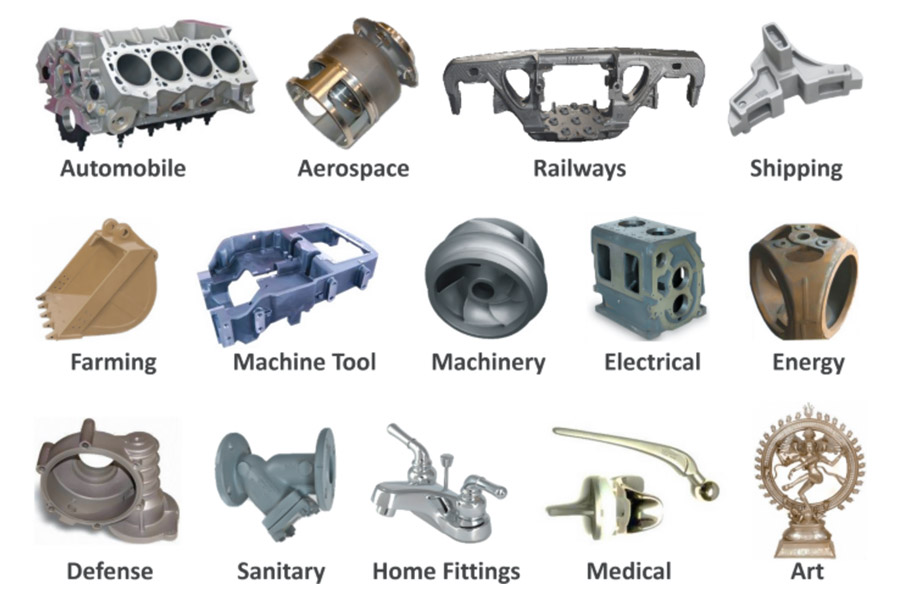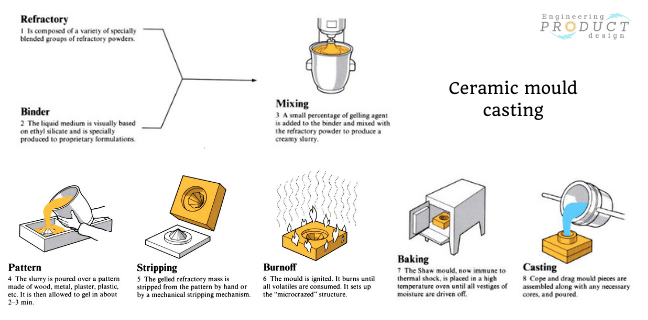Comprehending the Steel Castings Process: A Comprehensive Overview for Beginners
The Metal Casting process is a basic strategy in manufacturing that changes molten metal into solid forms. Novices have to grasp the different techniques entailed, such as sand casting and die spreading. Understanding the materials, design concepts, and precaution is equally essential. Each facet plays an important function in accomplishing effective results. As one navigates these intricacies, the concern of how to maximize each action for enhanced results comes to be significantly significant.
The Fundamentals of Metal Casting
Metal Casting has progressed over centuries, its basic principles continue to be essential and constant to the manufacturing process. At its core, Metal Casting includes the improvement of molten metal right into solid objects with various methods. The process begins with the development of a mold and mildew, which specifies the shape of the end product. As soon as the mold is prepared, steel is heated up to its melting factor and put into the tooth cavity. After cooling down, the metal strengthens, taking the shape of the mold.
There are numerous casting approaches, consisting of sand casting, financial investment spreading, and die casting, each with special benefits and applications. The choice of method relies on factors such as production volume, product type, and wanted accuracy. Once cast, the end product may undergo added procedures like machining or surface treatment to accomplish the needed coating and specs. Understanding these essentials is essential for anybody thinking about the field of Metal Casting.

Understanding Materials Utilized in Metal Casting
Materials play a crucial function in the Metal Casting process, influencing the final item's buildings and efficiency. Different metals are utilized, consisting of aluminum, bronze, iron, and steel, each offering distinctive characteristics matched for certain applications. Light weight aluminum is lightweight and corrosion-resistant, making it ideal for automobile components. Iron, specifically cast iron, is preferred for its excellent wear resistance and toughness. Steel supplies high strength and flexibility, often utilized in hefty machinery parts. Bronze, known for its deterioration resistance and machinability, is frequently employed in aquatic applications.
In addition to the metals, different casting products, such as sand, plaster, and ceramic, are utilized to produce molds. Sand casting, one of the most common technique, uses silica sand due to its thermal stability and ability to form complex shapes. Plaster and ceramic molds offer finer information however might call for more complicated processes. The choice of materials directly affects the effectiveness, cost, and top quality of the casting operation.
The Layout Process: From Principle to Blueprint
The style procedure in Metal Casting begins with the preliminary concept growth, where ideas are created and evaluated. This is complied with by the application of CAD modeling techniques, permitting for exact visualizations of the style. The plan finalization actions assure that all specifications are properly documented for production.
Preliminary Principle Development
Preliminary concept development marks a vital stage in the Metal Casting process, where ideas change into concrete designs. During this stage, designers team up with stakeholders and designers to brainstorm and fine-tune first principles. They think about factors such as performance, aesthetics, and manufacturability, making sure that the style fulfills the required requirements and efficiency requirements. Illustrations and rough drafts are created to imagine the ideas, enabling preliminary evaluations of expediency and cost-effectiveness. This phase additionally includes identifying materials and possible casting techniques that line up with the layout goals. Eventually, first concept growth lays the foundation for a detailed plan, assisting the subsequent phases of the spreading process and making certain a successful change from concept to fact.
CAD Modeling Techniques
Changing concepts into specific styles, CAD modeling methods play an essential role in the Metal Casting process. These strategies utilize innovative software program to develop thorough three-dimensional models that precisely reflect the desired product. By employing devices such as parametric modeling, solid modeling, and surface area modeling, developers can control dimensions and forms with simplicity. CAD systems additionally facilitate simulation and evaluation, allowing for the identification of potential imperfections before production starts. This aggressive technique reduces material waste and optimizes the design for manufacturability. Additionally, CAD models can be easily changed, allowing quick models based upon responses. Fundamentally, CAD modeling functions as the foundation of the layout process, bridging the gap between first principles and the eventual production-ready designs.
Blueprint Completion Tips
Complying with the creation of comprehensive CAD versions, the next stage includes blueprint completion, which is important in translating digital styles right into actionable plans for manufacturing. This procedure starts with reviewing the CAD designs for precision and conformity with specifications. Once validated, the dimensions, resistances, and material requirements are meticulously detailed to assure quality. Including notes and notes assists connect important information concerning casting processes, surface area coatings, and assembly needs. The finalized blueprint undertakes an extensive authorization procedure, usually including collaboration with engineers and manufacturing teams to deal with any kind of potential concerns. Modifications are made and approvals obtained, the plan is officially released, offering as the fundamental paper for the succeeding stages of Metal Casting, including pattern making and mold style.
The Steel Casting Methods Described

Metal Casting methods encompass a selection of techniques used to form liquified steel into wanted kinds. These strategies differ according to the kind of material, complexity of the layout, and production volume. Sand spreading is among the most typical approaches, entailing the production of a mold from sand to hold the liquified steel. Financial investment spreading, or lost-wax casting, allows for intricate styles by utilizing a wax pattern that is melted away. Pass away casting uses high-pressure shot of molten metal into a mold, suitable for automation. Various other methods include irreversible mold and mildew spreading, which utilizes multiple-use molds, and centrifugal spreading, where rotational pressures assist in filling up the mold. Each technique has its benefits and applications, making it crucial for makers to pick the suitable method based on their specific demands and demands. Comprehending these techniques is essential for any individual entailed in the Metal Casting procedure.
Ending Up Processes: Enhancing Your Casted Product

Completing processes play a crucial role in enhancing the top quality and look of casted items. Different surface area treatment strategies, such as polishing and layer, are employed to boost resilience and looks. In addition, quality evaluation techniques ensure that the final product fulfills defined criteria and performance demands.
Surface Treatment Strategies
A selection of surface therapy techniques play a crucial role in boosting the high quality and durability of casted items. These strategies include approaches such as shot blasting, brightening, and finish. Shot blasting effectively removes surface area blemishes, boosting the practical and visual attributes of the spreading. Sprucing up provides a smooth coating, which is particularly crucial for attractive applications and components calling for marginal rubbing. Layer methods, such as electroplating or powder finish, offer added protection against deterioration and wear, ensuring resilience. Surface area therapies can boost bond for subsequent processes, such as painting or bonding. look at more info By employing these techniques, suppliers can achieve exceptional surface high quality, which is vital for the performance and lifespan of Metal Casting in numerous applications.
Quality Inspection Approaches
Efficient quality assessment approaches are important for ensuring the honesty and performance of casted products after the finishing procedures. Various strategies are employed to analyze the quality of Metal Casting, consisting of aesthetic evaluation, dimensional checks, and non-destructive screening (NDT) Read Full Article Aesthetic evaluation enables the recognition of surface area problems, while dimensional checks guarantee that items satisfy defined resistances. NDT techniques, such as ultrasonic screening and radiographic assessment, offer deeper insights right into internal integrity without damaging the spreadings. Furthermore, mechanical screening, such as tensile and solidity tests, evaluates material buildings - Aluminum Castings. By utilizing a combination of these methods, manufacturers can boost item top quality and reliability, ultimately resulting in greater consumer satisfaction and lowered manufacturing expenses
Security Considerations in Metal Casting
While the Metal Casting process uses numerous benefits, it also presents a series of safety and security dangers that need to be meticulously taken care of. Workers in casting facilities are exposed to heats, molten steels, and dangerous materials, which can lead to extreme injuries if proper precautions are not taken. Personal safety devices (PPE) such as heat-resistant gloves, face shields, and protective garments is important to minimize threats.
In addition, the presence of fumes and dust requires proper ventilation systems to ensure air high quality - Aluminum Castings. Normal training on safety methods is vital for all employees to recognize potential hazards and respond properly. Emergency treatments should be developed, including fire safety actions and emergency treatment accessibility. Maintenance of devices and proper handling of materials additionally contribute to a much safer working environment. By prioritizing these safety and security factors to consider, next page Metal Casting operations can protect their labor force and maintain efficient production procedures
Often Asked Inquiries
What Are the Ecological Influences of Metal Casting?
Metal Casting can result in environmental effects such as air and water contamination, resource deficiency, and power intake. Furthermore, inappropriate waste monitoring and exhausts from factories add to eco-friendly disturbances and wellness risks for neighboring neighborhoods.
Just how Do I Choose the Right Metal for Spreading?
To choose the appropriate steel for casting, one have to take into consideration aspects such as mechanical properties, deterioration resistance, thermal conductivity, and cost. Evaluating the desired application and ecological conditions is important for excellent selection.
What Are the Common Defects in Metal Casting?
Common problems in Metal Casting consist of porosity, contraction, sand addition, and misruns. These problems typically occur from inappropriate product selection, insufficient style, or defects in the spreading procedure, affecting the end product's quality and efficiency.
How Can I Improve My Metal Casting Skills?
To improve Metal Casting skills, one must practice regularly, research study spreading strategies, assess previous tasks for problems, look for comments from experienced casters, and constantly explore various materials and methods to boost efficiency and understanding.
What Is the Price of Beginning a Steel Spreading Organization?
Starting a metal casting service typically calls for a preliminary investment of $5,000 to $50,000, depending on tools, materials, and facility prices. Aspects like place and scale can considerably affect total startup expenses.
The Metal Casting process is a basic method in making that changes molten metal right into strong types. Newbies should understand the various techniques involved, such as sand casting and die spreading. There are a number of casting methods, including sand spreading, investment casting, and pass away casting, each with distinct benefits and applications. Financial investment casting, or lost-wax casting, enables for elaborate designs by using a wax pattern that is melted away. Various other methods consist of irreversible mold and mildew casting, which utilizes reusable mold and mildews, and centrifugal casting, where rotational pressures assist in loading the mold.